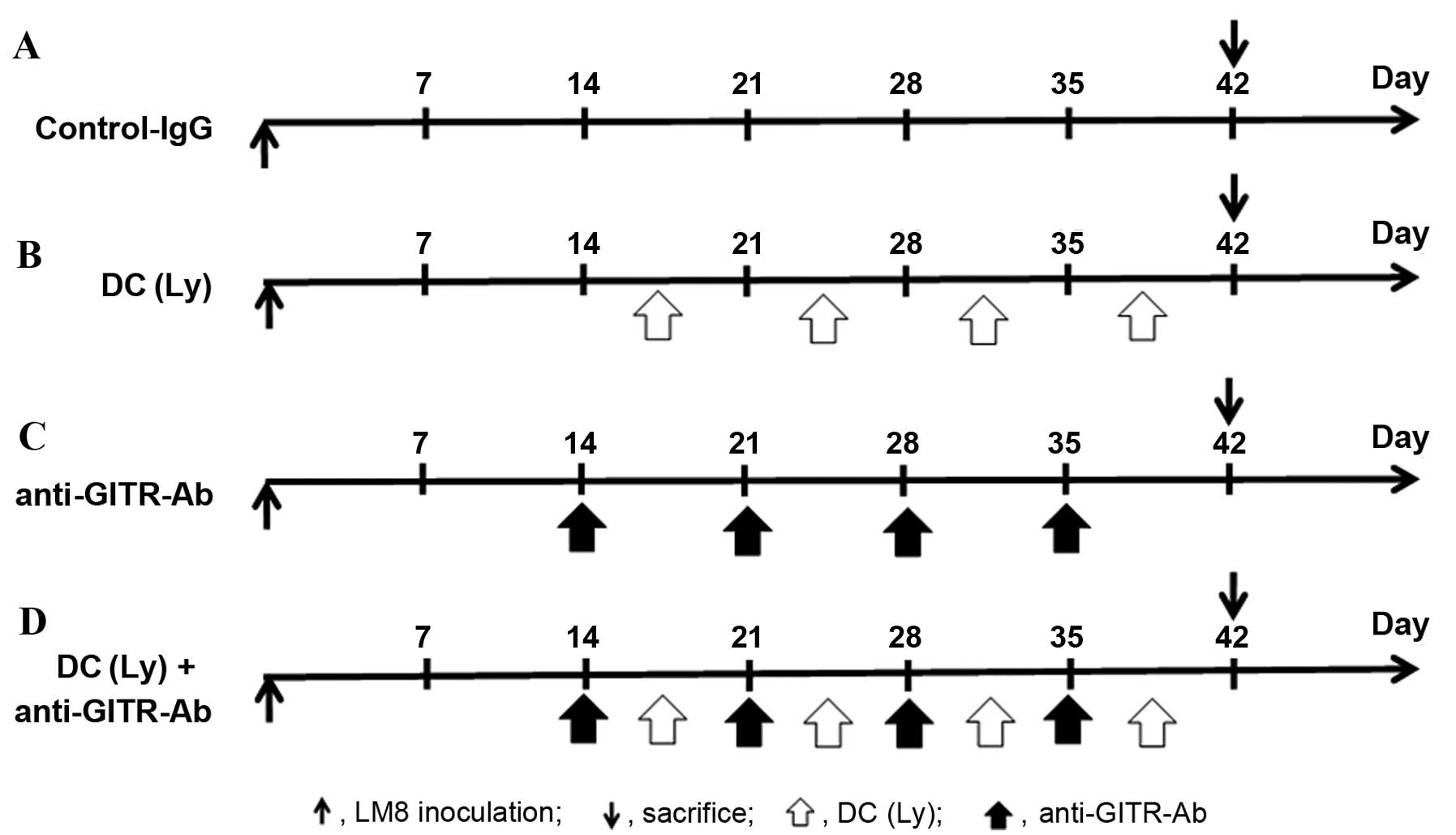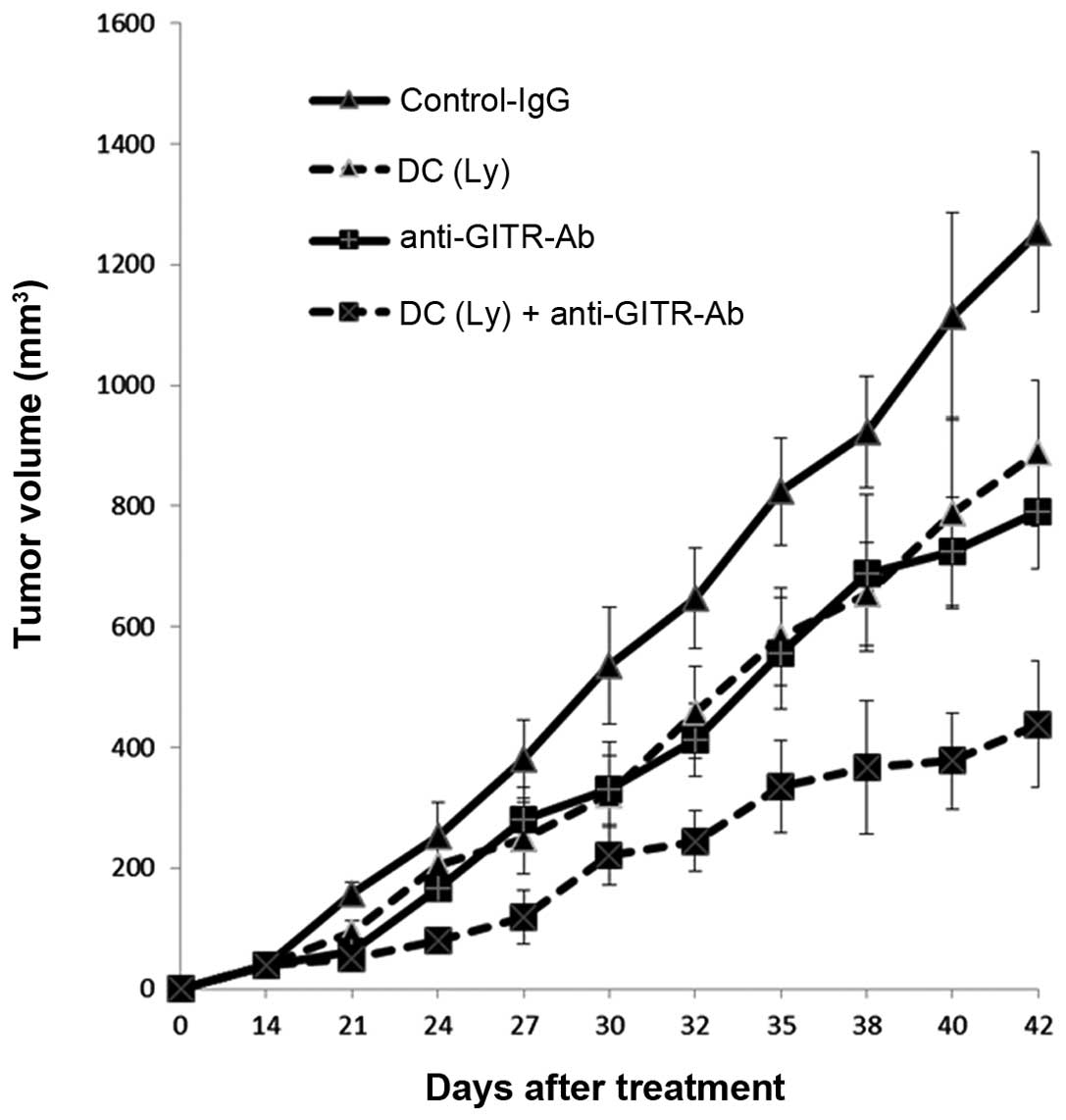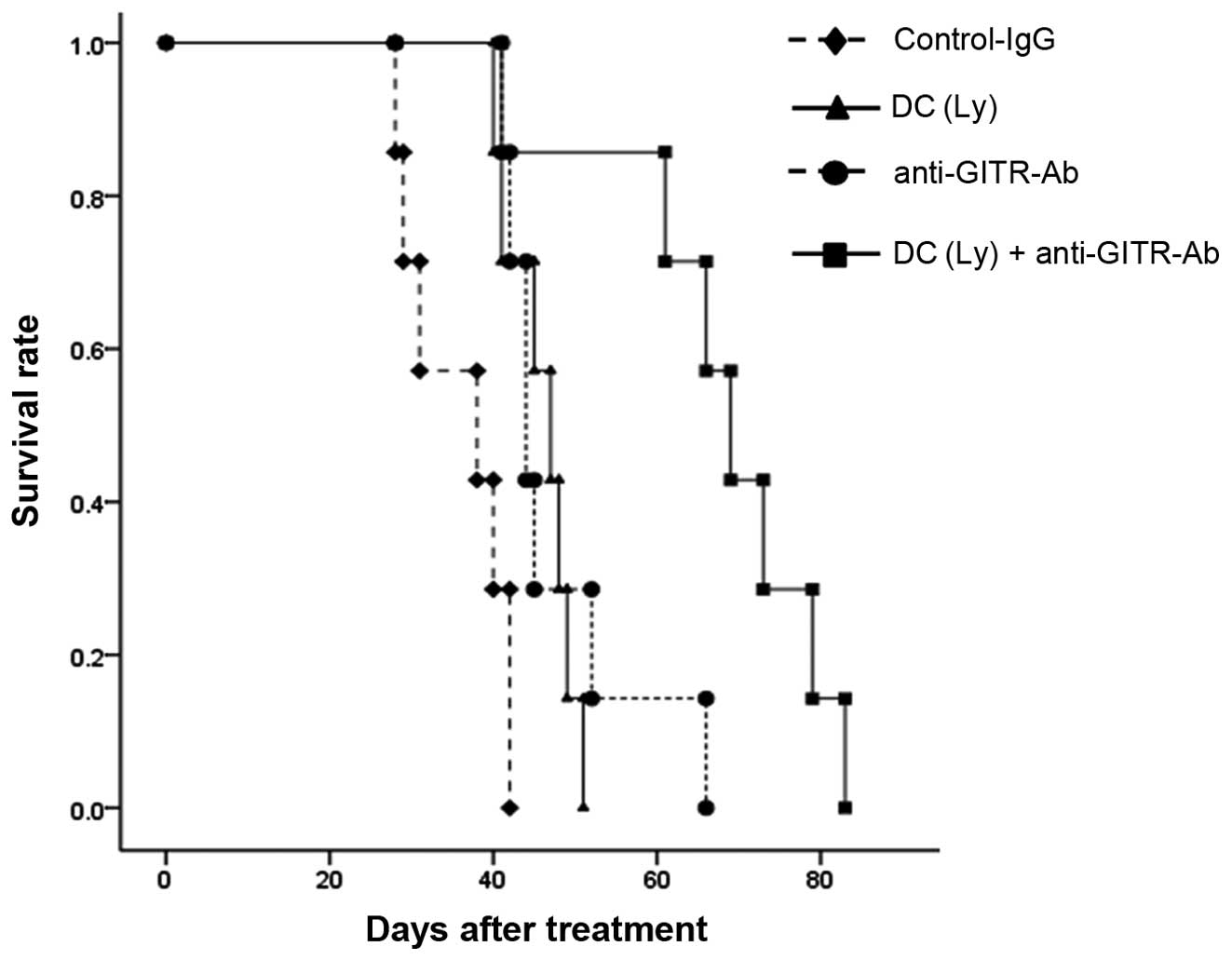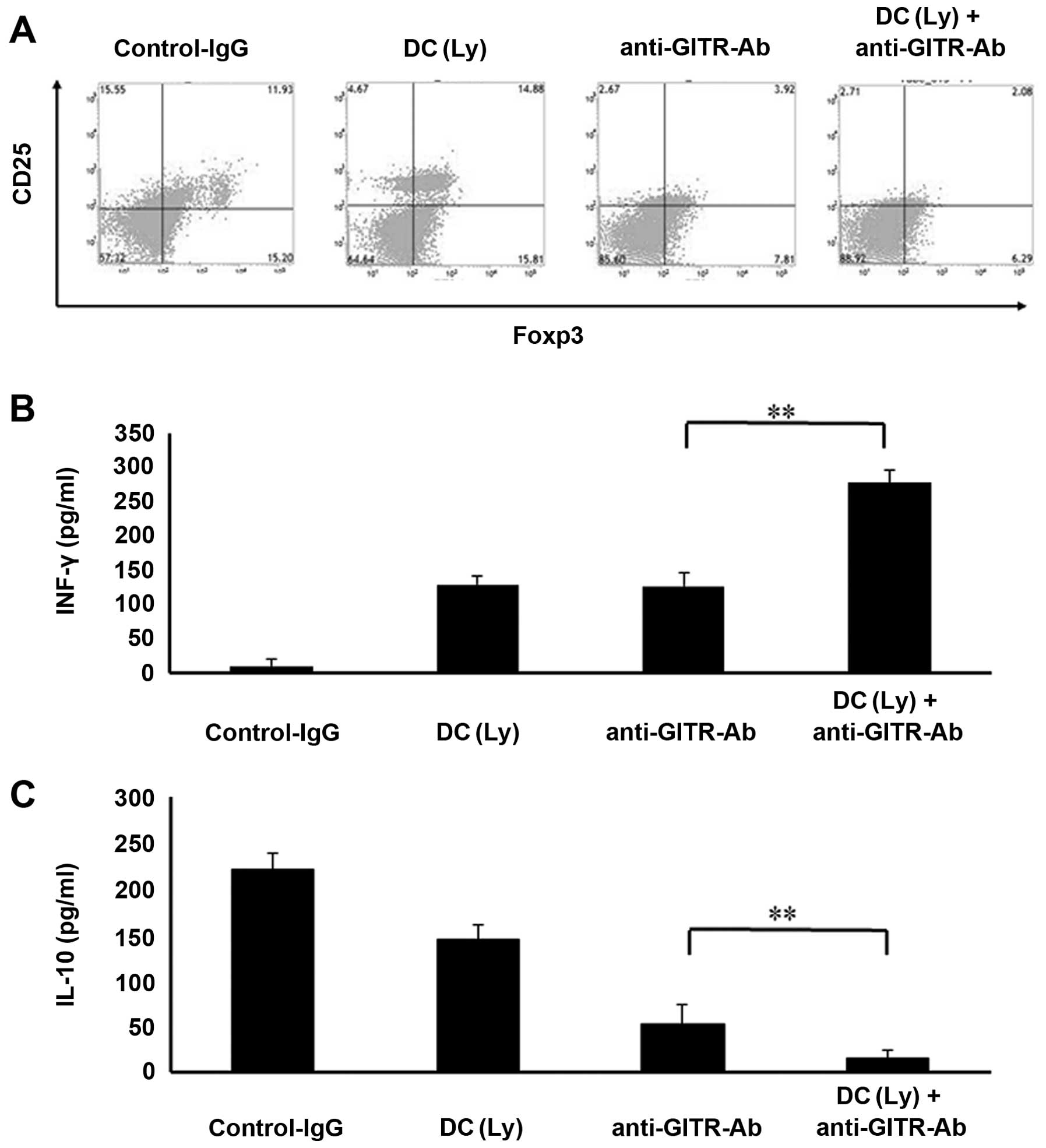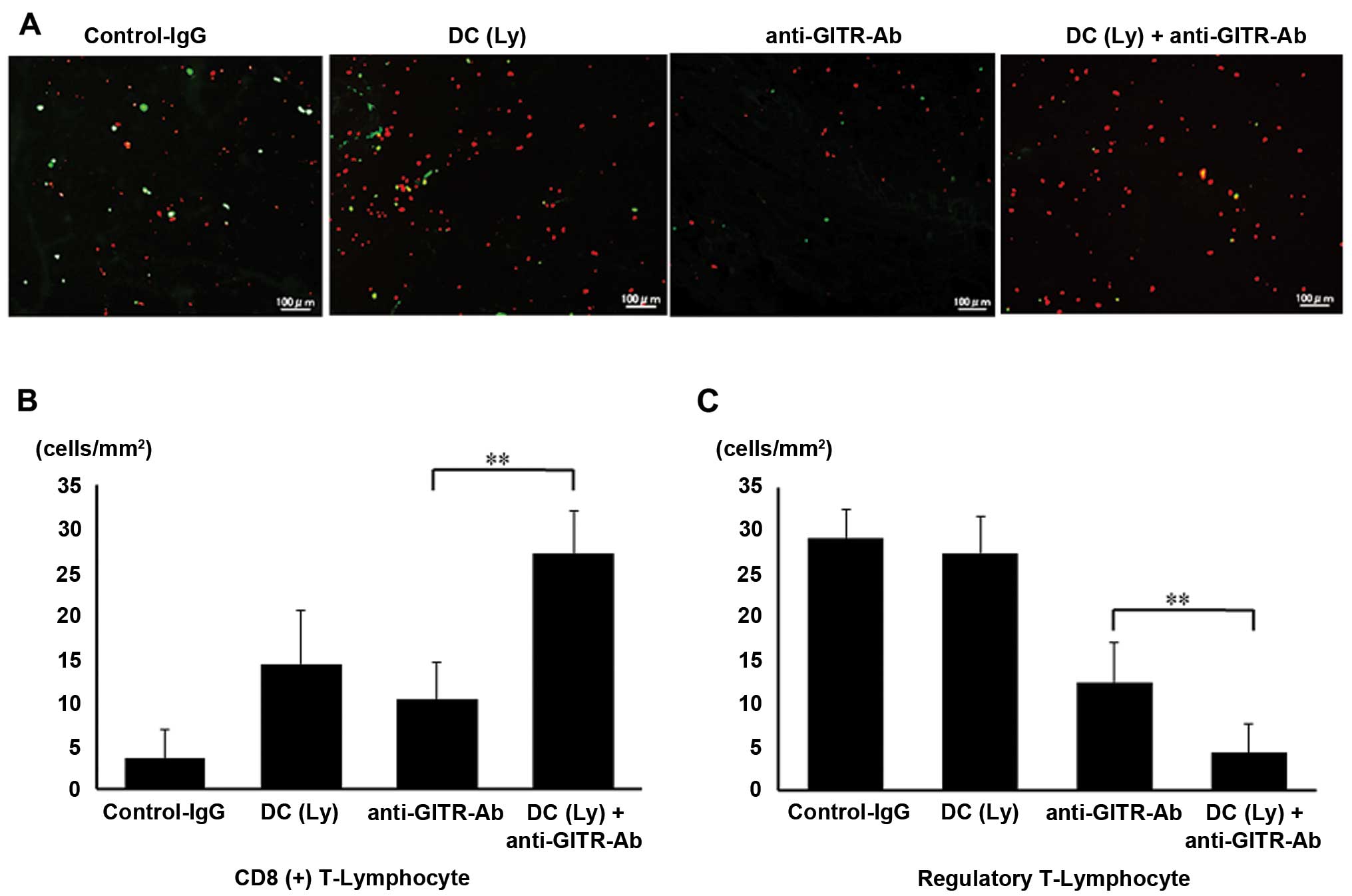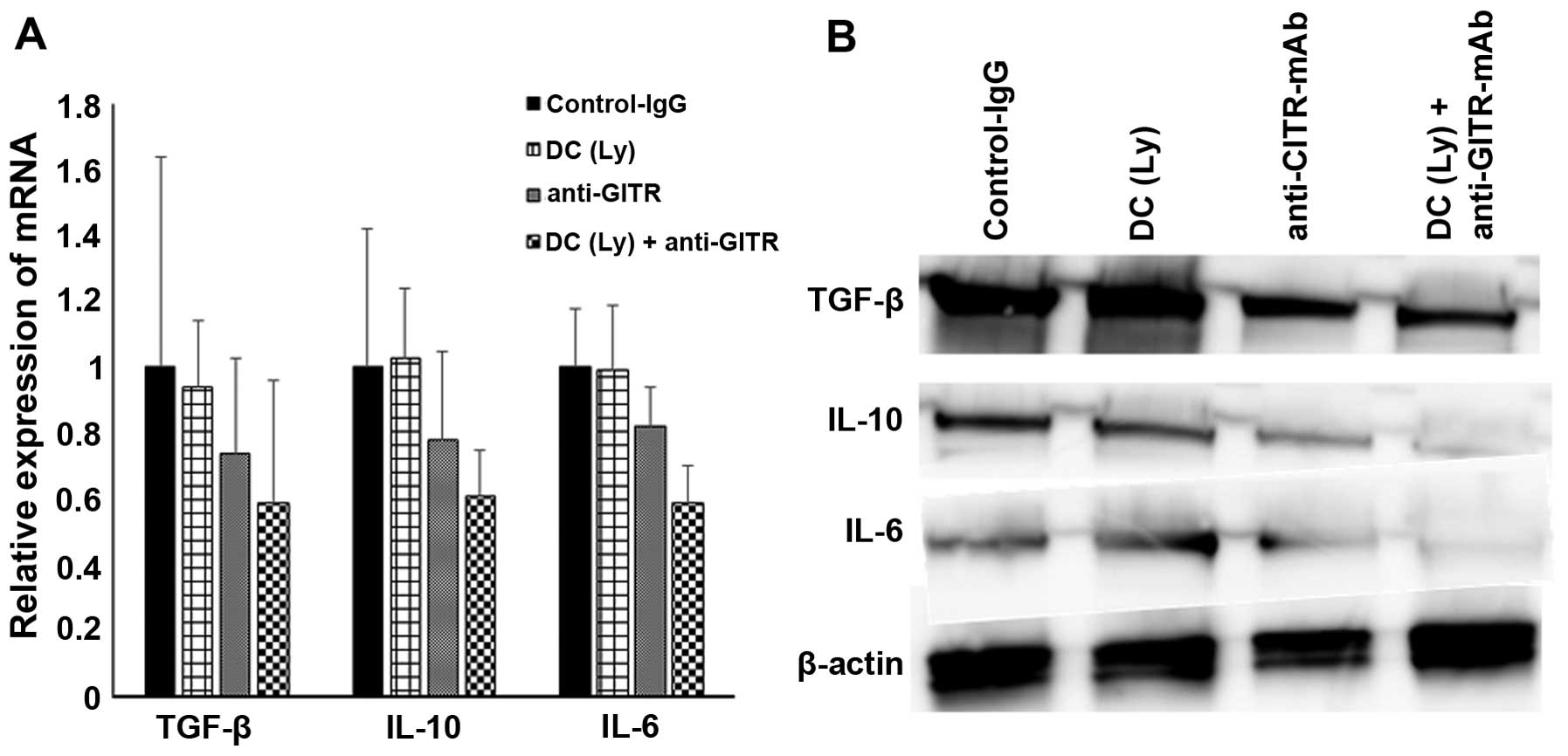Dendritic cells combined with anti-GITR antibody produce antitumor effects in osteosarcoma
- Authors:
- Published online on: July 29, 2015 https://doi.org/10.3892/or.2015.4161
- Pages: 1995-2001
Abstract
Introduction
Osteosarcoma is the most common primary malignant tumor of the bone. Remarkable advances in the treatment of osteosarcoma have been made in the past 2–3 decades. These include the introduction of adjuvant chemotherapy and appropriate surgical excision (1,2). However, there have also been advances in the field of immunotherapy for osteosarcoma that have received less attention (3,4). We developed a method using dendritic cells (DCs) to enhance tumor-specific immunoreactions based on the premise that DCs are the main antigen-presenting cells initiating cell-mediated immune responses in vivo (5). Our current strategy involves eliminating immunosuppressive factors such as regulatory T cells (Tregs) and enhancing cell-mediated immunity.
The glucocorticoid-induced tumor necrosis factor receptor (GITR) family-related protein is constitutively expressed at high levels on Tregs and presented ubiquitously at lower levels on various immune subsets including cytotoxic T lymphocytes (CTLs) (6,7). GITR ligation provides a costimulatory signal that enhances CD4+ and CD8+ T cell proliferation and effector functions, particularly in the context of suboptimal T cell receptor stimulation (8,9). Signaling through GITR, using agonist anti-GITR antibodies or GITR ligands abrogates the suppressive effects of Tregs (7,10) and enhances T cell responses (6,8,9,11). Administration of agonist anti-GITR antibodies promotes the activation of CTLs, and interferon (IFN)-γ is reportedly required for the antitumor response induced by anti-GITR antibodies (12,13). Recently, several studies showed that in vivo GITR ligation by using anti-GITR antibodies can augment antitumor T cell responses and induce tumor rejection (14–16). However, the efficacy of the combination of tumor lysate-pulsed DCs and agonist anti-GITR antibodies in an osteosarcoma model has not been evaluated. Therefore, we hypothesized that an antitumor effect may be triggered if Tregs are controlled, resulting in the activation of CTLs and inhibition of tumor growth.
We investigated how immunotherapies that target the inhibitory pathways of Tregs using anti-GITR-mAbs can potentially synergize the effects of cryotreated tumor lysate-pulsed DCs to generate systemic antitumor immunity. We verify that, in contrast to tumor lysate-pulsed DC or anti-GITR-Ab treatment alone, the combination therapy enhanced antitumor immunity and slowed the growth.
Materials and methods
Cell line
LM8 cells, derived from Dunn osteosarcoma, were provided by the Riken BioResource Center (Saitama, Japan). The cells were maintained in complete medium consisting of RPMI-1640 supplemented with 10% heat-inactivated fetal bovine serum, 100 μg/ml streptomycin and 100 U/ml penicillin. Cells were cultured at 37°C in 5% CO2.
A total of 1×106 LM8 cells (a murine osteosarcoma cell line) was hypodermically implanted into the subcutaneous gluteal region of 20 female C3H mice 6–8 weeks old. We purchased the C3H mice from Sankyo Labo Inc. (Toyama, Japan) and housed them in a specific pathogen-free animal facility in our laboratory.
DC generation
Bone marrow-derived DCs were generated as described by Lutz and Rössner (17) with minor modifications (5). Two weeks after tumor inoculation, we resected the primary tumor lesion and soaked the entire tumor in liquid nitrogen to kill the tumor cells. The freeze-thawed tumor lysate was added to the DC cultures on day 6 at a ratio of five DC equivalents to one tumor cell (i.e., 5:1) and incubated at 37°C in an atmosphere containing 50 ml CO2 per liter. The homogenate was passed through a 0.2-μm filter to remove bacteria and tissues and mixed with the DCs for 24 h. After 24 h of incubation, non-adherent cells including DCs were harvested by gentle pipetting.
Antibody administration
Mice received 0.5 mg/mouse of agonistic affinity-purified anti-GITR monoclonal antibody (rat anti-mouse IgG; BioExpress). The control antibody is monoclonal antibody IgG (rat anti-mouse IgG, isotype control antibodies, 0.5 mg/mouse).
Study design
All the animals developed tumors. The following 4 groups were established (Fig. 1): i), control IgG (control, n=5); ii), DCs exposed to cryotreated tumor lysates were injected twice a week into the subcutaneous contralateral gluteal region [DC(Ly), n=5]; iii), intraperitoneal injection of agonist anti-GITR antibody was performed twice per week (anti-GITR-Ab, n=5); and iv), DCs exposed to cryotreated tumor lysates and injected twice a week into the subcutaneous contra-lateral gluteal region and intraperitoneal injection of agonist anti-GITR antibody was performed twice per week [DC(Ly) + anti-GITR-Ab, n=5]. All experiments were performed under the guidelines for animal experiments as stipulated by the Oita University Graduate School of Medical Science. Tumor size was measured in 2 perpendicular dimensions parallel with the surface and the depth of the tumor in mice using a caliper.
Flow cytometry
The markers Foxp3 and CD4, which are expressed on the surface of Tregs, were counted with a FACSVerse™ flow cytometer (Becton-Dickinson, San Jose, CA, USA) and stained them with fluorochrome-conjugated antibody (BD Pharmingen, Tokyo, Japan) for the following markers: phycoerythrin (PE)-conjugated anti-mouse Foxp3 staining kit (eBioscience, San Diego, CA, USA) and fluorescein isothiocyanate (FITC)-conjugated rat anti-mouse CD4 (clone, RM4-5; BD Pharmingen). Data analysis was performed with FACSuite™ software (Becton-Dickinson).
Immunohistofluorescence
Immunohistochemistry was used to measure the levels of Foxp3, a marker of Tregs, and CD8, a marker of CTLs, inside primary tumor lesions. Lung specimens were fixed in frozen section. Five samples per mouse were cut into 15-μm-thick slices. Rehydrated tissue sections were incubated with primary Abs against CD8+ (Santa Cruz Biotechnology, Santa Cruz, CA, USA) and Foxp3 (Abcam, Cambridge, MA, USA) diluted at 1:200 in Ab Diluent (Dako ChemMate, Dako, Japan) overnight at room temperature. For CD8+ staining with FITC donkey anti-rabbit IgG and Foxp3+ staining with Texas red goat anti-rat IgG (Invitrogen, Carlsbad, CA, USA), secondary antibodies were diluted at 1:300 in Ab Diluent and added for 60 min at room temperature in the dark. Digital images were taken on a BIOREVO microscope equipped with a confocal microscopy system (BZ-9000; Keyence, Japan).
ELISA
We measured murine IFN-γ and IL-10 release by enzyme-linked immunosorbent assay using Quantikine® (R&D Systems, Minneapolis, MN, USA) according to the manufacturer's instructions using a Skanlt for Multiskan FC microplate reader (Thermo Fisher Scientific, Tokyo, Japan).
Western blot analysis
Tumor tissue was dissected and washed briefly with chilled PBS, then cut into smaller pieces whilst keeping on ice. The tissue was placed in a homogenizer adding RIPA buffer (500 μl per 10 mg of tissue) with protease inhibitor. Tissue was homogenized thoroughly and kept on ice for 30 min. Total cellular protein (15 μg) was resolved on a precast 10% Tris-HCl Criterion 10-well gel (Bio-Rad) at 200 V (300 mAmp) for 30 min. The gel was wet-transferred to a PVDF membrane for 1 h, and blocked with PBST containing 5% instant dry non-fat milk for 30 min at room temperature. Antibodies against transforming growth factor (TGF)-β (#3711) was obtained from Cell Signaling Technology (Tokyo, Japan); IL-10 (sc-7888) was obtained from Santa Cruz Biotechnology (Dallas, TX, USA); and IL-6 (ab6672) and β-actin (ab16039) were from Abcam (Cambridge, UK). Immunocomplexes were visualized with horseradish peroxidase-conjugated anti-rabbit immunoglobulin G antibodies, and developed using ECL Plus system with a ChemiDoc camera (ImageQuant LAS 4000 mini) (all from GE Healthcare, Tokyo, Japan). The quantification of western blot signals was performed by the densitometry with ImageQuant TL software (GE Healthcare). All western blot experiments were repeated at least 3 times.
Cell isolation from fresh tumor tissues and spleen
LM8 cells were inoculated into C3H mice, and 28 days after the injection, spleen cells were prepared. The tumor tissues were dissected from the mice and minced.
Fresh tumor specimens were gently minced over a wire mesh screen to obtain a cell suspension. The cell suspension was layered over Ficoll-Hypaque (GE Healthcare) and centrifuged at 500 x g for 30 min. After density gradient centrifugation, mononuclear cells were collected and washed with RPMI-1640 medium (Gibco, Carlsbad, CA, USA) containing 5% fetal bovine serum and 1% penicillin/streptomycin. Peripheral blood mononuclear cells (PBMCs) were also isolated by Ficoll-Hypaque density gradient centrifugation. PBMCs were collected, washed, and analyzed immediately. Viable cell counts were obtained using trypan blue dye. For isolation of CD3+CD4+CD25high CD127low, the cells prepared from tumor tissues were stained with APC/Cy7-conjugated anti-CD3 mAb (M1/70), FITC-conjugated anti-CD4 mAb (M1/70), Pacific Blue-conjugated anti-CD25 mAb (M1/70) and Alexa Fluor 647-conjugated anti-CD127 mAb (RB6-8C5) (all from BD Biosciences, San Jose, CA, USA). The percentages of CD25high CD127low cells were determined using BD LSRFortessa™ X-20 cell analyzer and analyzed with BD FACSDiva (BD Biosciences). The population of CD25high CD127low cells was isolated by FACSAria II (BD Biosciences). The purity of the isolated cells was consistently >95%.
RNA extraction, cDNA synthesis and quantitative real-time PCR
Total RNA was extracted from prepared isolated Tregs with the TRIzol reagent (Invitrogen) and cDNA was synthesized according to the manufacturer's instructions (Roche). Quantitative real-time PCR (qRT-PCR) was performed using a LightCycler 480 Probe Master system (Roche), and PCR-specific amplification was conducted in the LightCycler® Nano (Roche). The relative expression of genes, TGF-β, IL-6, IL-10 and glyceraldehyde-3-phosphate dehydrogenase (GAPDH), were calculated with the 2−ΔΔCt method. The primer and probe kit of TGF-β, IL-6, IL-10 and GAPDH were obtained from Applied Biosystems (Nagoya, Japan).
Statistical analysis
We determined differences among the 4 groups using a non-repeated measures analysis of variance (ANOVA) and the Scheffe's test. All analyses were conducted using SPSS® 18.0 software (SPSS Japan Inc., Tokyo, Japan). Results were expressed as the mean ± standard deviation, and P<0.01 was considered statistically significant. For survival analysis, the differences in survival rates were analyzed by log-rank test.
Results
Tumor volume of the primary tumor
Forty-two days after inoculation, the volume of the primary lesion in mice that received tumor lysate-pulsed DCs and the agonist anti-GITR antibody (271.86±139.11 mm3) was lower (P<0.01) than in the mice that received tumor lysate-pulsed DCs (627.06±119.13 mm3) or the agonist anti-GITR antibody alone (571.08±149.47 mm3). The volume of the primary lesion in mice that received tumor lysate-pulsed DCs and the agonist anti-GITR antibody (438.45±103.97 mm3) was lower (P<0.01) than that in the mice that received tumor lysate-pulsed DCs (887.87±121.19 mm3) or the agonist anti-GITR antibody alone (701.47±95.97 mm3) (Fig. 2).
Survival rate
The median survival time was in IgG control, 35.7 days (range, 28–42); tumor lysate-pulsed DCs, 45.9 days (range, 40–51); anti-GITR antibody, 47.7 days (range, 41–66); and the tumor lysate-pulsed DCs and the anti-GITR-4 antibody group, 67.4 days (range, 41–83). Survival was significantly prolonged but differences in tumor lysate-pulsed DCs alone and anti-GITR antibody alone group were small compared with control IgG group (P<0.01). There was no significant difference between the tumor lysate-pulsed DCs alone and anti-GITR antibody alone groups. Further lifetime prolongation was observed in tumor lysate-pulsed DCs and the anti-GITR antibody group compared with the tumor lysate-pulsed DCs alone and anti-GITR antibody alone groups (P<0.01, Fig. 3).
Characterization of distinct subsets of CD25+Foxp3+ T cells in the spleen
Agonist anti-GITR antibodies markedly reduced the CD4+Foxp3+ Treg population in the spleen. The groups that received agonist anti-GITR antibodies alone or in combination with tumor lysate-pulsed DCs displayed marked decreases in the proportion of CD4+Foxp3+ cells compared to the control IgG or tumor lysate-pulsed DC-treated groups (Fig. 4A).
Cytokine release
Mice treated with tumor lysate-pulsed DCs and the agonist anti-GITR antibody displayed higher serum IFN-γ levels (278.33±18.64 pg/ml, P<0.01) than those that received tumor lysate-pulsed DCs (129.6±13.28 pg/ml) or the anti-GITR antibody alone (144.98±20.37 pg/ml, Fig. 4B). Serum IL-10 levels were lower (P<0.01) in mice that received the anti-GITR antibody alone (53.24±21.29 pg/ml) than in those that received tumor lysate-pulsed DCs alone (145.43±16.38 pg/ml). Serum IL-10 levels were lower (P<0.01) in mice that received tumor lysate-pulsed DCs and the anti-GITR antibody (15.38±9.26 pg/ml) than in those that received the anti-GITR antibody alone (53.24±21.29 pg/ml, Fig. 4C).
Infiltration of CD8+ T lymphocyte and Tregs in the tumor
Foxp3 levels were significantly decreased, whereas CD8+ T cell numbers were significantly increased in the primary tumor lesions in the agonist anti-GITR antibody-treated group. Foxp3+ cells were not recruited to the primary area in the agonist anti-GITR antibody-treated group, but were recruited in the control IgG-treated group (Fig. 5A). The number of CD8+ T lymphocytes per unit area was higher (P<0.01) in mice that received tumor lysate-pulsed DCs and the agonist anti-GITR antibody (26.99±5.03 cells/mm2) than in those that received tumor lysate-pulsed DCs (12.34±6.22 cells/mm2) or agonist anti-GITR antibody alone (11.18±4.32 cells/mm2, Fig. 5B). The number of Foxp3+ T lymphocytes per unit area was lower (P<0.01) in mice that received the agonist anti-GITR antibody (12.49±4.59 cells/mm2) than in those that received tumor lysate-pulsed DCs (27.38±4.31 cells/mm2). The number of Foxp3+ T lymphocytes per unit area was lower (P<0.01) in mice that received tumor lysate-pulsed DCs and the agonist anti-GITR antibody (4.31±3.29 cells/mm2) than in those that received the agonist anti-GITR antibody alone (Fig. 5C).
Immunosuppressive activity of tumor-infiltrating Tregs and tumor tissue
To confirm the immunosuppressive activity of Tregs which gathered in the tumor, we analyzed the expression levels of TGF-β, IL-6 and IL-10 on Tregs sorted from tumor tissues. The expression of TGF-β (0.59-fold), IL-6 (0.61-fold), and IL-10 (0.59-fold) were significantly lower in DC with anti-GITR-Ab group compared with the control-IgG, DC alone and anti-GITR-Ab alone group as determined by real-time quantitative RT-PCR (Fig. 6A). We also performed immunoblot analysis to evaluate the protein levels of those immunosuppressive molecules using tumor tissue lysate. Western blot analysis showed that the expression levels of TGF-β, IL-10 and IL-6 of tumor tissue dramatically decreased in DC and anti-GITR-Ab compared with control-IgG, DC alone, and anti-GITR-Ab alone group (Fig. 6B).
Discussion
Most osteosarcoma patients are treated with some combination of surgery, radiation and chemotherapy. Despite recent advances in local therapies with curative intent, chemotherapeutic treatments for primary disease are unsatisfactory owing to severe adverse effects and incomplete long-term remission. Therefore, the development of novel therapeutic options is of great interest. Several immunotherapies have been investigated as new methods to overcome progressive cancers (18-21). We focused on the inability to control immunosuppressive factors such as Tregs, which inhibit attacker cells, such as DCs and CD8+ T lymphocytes; as a result, Tregs are a major cause of insufficient antitumor effects. Since the initial discovery that GITR stimulation drives T cell immunity (10), agonistic anti-GITR has been used extensively for tumor immunotherapy, and GITR stimulation has been shown to drive potent CD8+ T cell-mediated tumor protection (13,22). The proportion of Tregs in tumor tissues is dramatically reduced, which appears to be a direct consequence of depletion (23–25). Our aims were to evaluate Tregs by using the Foxp3 and CD4, in the spleens of mice; measure the levels of Foxp3 and determine the numbers of CD8+ T lymphocytes inside the primary and primary tumor lesions; determine the changes in the primary and tumor volumes; measure the levels of IFN-γ and IL-10; and measure the expression levels of immune suppression factors, TGF-β, IL-10 and IL-6 from Tregs in the tumor tissue.
The group treated with the combination of tumor lysate-pulsed DCs and the anti-GITR antibody displayed smaller tumor lesions and the life time was prolonged. Importantly, the result of tumor rejection in the combined therapy group correlated with the intratumor ratio of CD8+ T cells to Tregs (26). This suggests that controlling immunosuppressive factors may facilitate the activity of DCs and CTLs in the tumor. The Treg depletion using anti-GITR antibody treatment combined with tumor lysate-pulsed DCs treatment showed significantly improved survival in comparison to the tumor lysate-pulsed DCs or anti-GITR antibody monotherapy groups.
The agonist anti-GITR antibody inhibited the proliferation of Tregs in the spleen. Inhibition of Treg accumulation in the spleen can enhance systemic cell-mediated immunity through the activation of DCs or CTLs. We believe that this result could reduce Treg accumulation and CD8+ T lymphocyte proliferation inthe tumor tissues.
The agonist anti-GITR antibody inhibited the accumulation of Tregs and induced the infiltration of CD8+ T cells in the primary lesions. GITR signaling in CD4+Foxp3+ Tregs is required for their immunosuppressive capacity (6,8,27). We demonstrated that stimulation of GITR led to the reduction of Foxp3+ T cells in the tumor tissues.
The group treated with the combination of tumor lysate-pulsed DCs and agonist anti-GITR antibodies also displayed smaller primary lesions. Tregs comprise one of the major components of the immunosuppressive microenvironment of tumor lesions (28). This is consistent with our results that tumor lesion volumes were significantly reduced in the combined therapy group, suggesting that controlling immunosuppressive factors may facilitate the activity of DCs and CTLs in the tumor microenvironment.
Stimulation of GITR induced the activation of cell-mediated immunity by increasing serum IFN-γ levels and decreasing serum IL-10 levels. Tregs are among the major factors that cause potent cytokine-mediated immunosuppression in tumor cells, and GITR stimulation may be useful for enhancing the efficacy of cancer therapy or vaccines (9). Our results revealed that stimulating GITR using agonist anti-GITR antibody enhanced cell-mediated immunity.
Tregs can inhibit immune cell functions either directly through cell-cell contact or indirectly through the secretion of immunosuppressive mediators, such as IL-10 and TGF-β (29). Hence, it is possible that by removing tumor-specific Tregs, antitumor immunity could be enhanced. Many studies in mice have shown that removal or inhibition of this subset of cells can enhance antitumor immune responses (30,31). Decreasing immunosuppressive cytokines by depleting tumor infiltrating Tregs by combining DCs and anti-GITR Abs could represent an important adjunct to cancer immunotherapy.
As a clinical application, GITR stimulatory therapy should involve the induction of antitumor immunity without adverse effects such as autoimmunity or cytokine storms. Continuous GITR stimulation has been linked to the exacerbation of autoimmune conditions (7,8). Several studies showed that melanocyte-specific autoimmunity could be avoided entirely via limited therapeutic administration of agonistic anti-GITR (14,32,33).
Taken together, our findings clearly support the therapeutic potential of agonist anti-GITR antibodies in osteosarcoma treatment. The effectiveness of GITR stimulation in humans has yet to be demonstrated. The present studies of concomitant and post-surgical immunity demonstrate that GITR stimulation during primary tumor growth could be sufficient for treating minimal residual disease or preventing tumor metastasis and recurrence. The synergistic effect of this combined chemoimmunotherapy using anticancer agents and immunotherapy with agonist anti-GITR antibodies could enhance self-reactive CTL responses, overcome self-tolerance, and induce long-lasting antitumor immunity (24). Future studies should be directed toward translating anti-GITR antibody therapy into clinical trials for evaluation of osteosarcoma treatments.
Acknowledgments
This study was performed at the Department of Orthopaedic Surgery, Faculty of Medicine, Oita University, Oita, Japan.
References
|
Ferrari S, Smeland S, Mercuri M, Bertoni F, Longhi A, Ruggieri P, Alvegard TA, Picci P, Capanna R, Bernini G, et al Italian and Scandinavian Sarcoma Groups: Neoadjuvant chemotherapy with high-dose ifosfamide, high-dose methotrexate, cisplatin, and doxorubicin for patients with localized osteosarcoma of the extremity: A joint study by the Italian and Scandinavian Sarcoma Groups. J Clin Oncol. 23:8845–852. 2005. View Article : Google Scholar : PubMed/NCBI | |
|
Kager L, Zoubek A, Dominkus M, Lang S, Bodmer N, Jundt G, Klingebiel T, Jürgens H, Gadner H and Bielack S; COSS Study Group: Osteosarcoma in very young children: Experience of the Cooperative Osteosarcoma Study Group. Cancer. 116:5316–324. 2010. View Article : Google Scholar : PubMed/NCBI | |
|
Campbell CJ, Cohen J and Enneking WF: Editorial: New therapies for osteogenic sarcoma. J Bone Joint Surg Am. 57:143–44. 1975.PubMed/NCBI | |
|
Kawaguchi S, Wada T, Tsukahara T, Ida K, Torigoe T, Sato N and Yamashita T: A quest for therapeutic antigens in bone and soft tissue sarcoma. J Transl Med. 3:312005. View Article : Google Scholar : PubMed/NCBI | |
|
Kawano M, Nishida H, Nakamoto Y, Tsumura H and Tsuchiya H: Cryoimmunologic antitumor effects enhanced by dendritic cells in osteosarcoma. Clin Orthop Relat Res. 468:1373–1383. 2010. View Article : Google Scholar : PubMed/NCBI | |
|
Kanamaru F, Youngnak P, Hashiguchi M, Nishioka T, Takahashi T, Sakaguchi S, Ishikawa I and Azuma M: Costimulation via gluco-corticoid-induced TNF receptor in both conventional and CD25+ regulatory CD4+ T cells. J Immunol. 172:7306–7314. 2004. View Article : Google Scholar : PubMed/NCBI | |
|
McHugh RS, Whitters MJ, Piccirillo CA, Young DA, Shevach EM, Collins M and Byrne MC: CD4(+)CD25(+) immunoregulatory T cells: Gene expression analysis reveals a functional role for the glucocorticoid-induced TNF receptor. Immunity. 16:311–323. 2002. View Article : Google Scholar : PubMed/NCBI | |
|
Kohm AP, Williams JS and Miller SD: Cutting edge: Ligation of the glucocorticoid-induced TNF receptor enhances autoreactive CD4+ T cell activation and experimental autoimmune encephalomyelitis. J Immunol. 172:4686–4690. 2004. View Article : Google Scholar : PubMed/NCBI | |
|
Tone M, Tone Y, Adams E, Yates SF, Frewin MR, Cobbold SP and Waldmann H: Mouse glucocorticoid-induced tumor necrosis factor receptor ligand is costimulatory for T cells. Proc Natl Acad Sci USA. 100:15059–15064. 2003. View Article : Google Scholar : PubMed/NCBI | |
|
Shimizu J, Yamazaki S, Takahashi T, Ishida Y and Sakaguchi S: Stimulation of CD25(+)CD4(+) regulatory T cells through GITR breaks immunological self-tolerance. Nat Immunol. 3:135–142. 2002. View Article : Google Scholar : PubMed/NCBI | |
|
Stephens GL, McHugh RS, Whitters MJ, Young DA, Luxenberg D, Carreno BM, Collins M and Shevach EM: Engagement of glucocorticoid-induced TNFR family-related receptor on effector T cells by its ligand mediates resistance to suppression by CD4+CD25+ T cells. J Immunol. 173:5008–5020. 2004. View Article : Google Scholar : PubMed/NCBI | |
|
Ko K, Yamazaki S, Nakamura K, Nishioka T, Hirota K, Yamaguchi T, Shimizu J, Nomura T, Chiba T and Sakaguchi S: Treatment of advanced tumors with agonistic anti-GITR mAb and its effects on tumor-infiltrating Foxp3+CD25+CD4+ regulatory T cells. J Exp Med. 202:885–891. 2005. View Article : Google Scholar : PubMed/NCBI | |
|
Ramirez-Montagut T, Chow A, Hirschhorn-Cymerman D, Terwey TH, Kochman AA, Lu S, Miles RC, Sakaguchi S, Houghton AN and van den Brink MR: Glucocorticoid-induced TNF receptor family related gene activation overcomes tolerance/ignorance to melanoma differentiation antigens and enhances antitumor immunity. J Immunol. 176:6434–6442. 2006. View Article : Google Scholar : PubMed/NCBI | |
|
Cohen AD, Diab A, Perales MA, Wolchok JD, Rizzuto G, Merghoub T, Huggins D, Liu C, Turk MJ, Restifo NP, et al: Agonist anti-GITR antibody enhances vaccine-induced CD8(+) T-cell responses and tumor immunity. Cancer Res. 66:4904–4912. 2006. View Article : Google Scholar : PubMed/NCBI | |
|
Nishikawa H, Kato T, Hirayama M, Orito Y, Sato E, Harada N, Gnjatic S, Old LJ and Shiku H: Regulatory T cell-resistant CD8+ T cells induced by glucocorticoid-induced tumor necrosis factor receptor signaling. Cancer Res. 68:5948–5954. 2008. View Article : Google Scholar : PubMed/NCBI | |
|
Turk MJ, Guevara-Patiño JA, Rizzuto GA, Engelhorn ME, Sakaguchi S and Houghton AN: Concomitant tumor immunity to a poorly immunogenic melanoma is prevented by regulatory T cells. J Exp Med. 200:771–782. 2004. View Article : Google Scholar : PubMed/NCBI | |
|
Lutz MB and Rössner S: Factors influencing the generation of murine dendritic cells from bone marrow: The special role of fetal calf serum. Immunobiology. 212:855–862. 2007. View Article : Google Scholar : PubMed/NCBI | |
|
Chauvin C, Philippeau JM, Hémont C, Hubert FX, Wittrant Y, Lamoureux F, Trinité B, Heymann D, Rédini F and Josien R: Killer dendritic cells link innate and adaptive immunity against established osteosarcoma in rats. Cancer Res. 68:9433–9440. 2008. View Article : Google Scholar : PubMed/NCBI | |
|
Kawano M, Itonaga I, Iwasaki T, Tsuchiya H and Tsumura H: Anti-TGF-β antibody combined with dendritic cells produce antitumor effects in osteosarcoma. Clin Orthop Relat Res. 470:2288–2294. 2012. View Article : Google Scholar : PubMed/NCBI | |
|
Southam CM, Marcove RC, Levin AG, Buchsbaum HJ and Miké V: Proceedings: Clinical trial of autogenous tumor vaccine for treatment of osteogenic sarcoma. Proc Natl Cancer Conf. 7:91–100. 1972.PubMed/NCBI | |
|
Yu Z, Ma B, Zhou Y, Zhang M, Qiu X and Fan Q: Activation of antitumor cytotoxic T lymphocytes by fusion of patient-derived dendritic cells with autologous osteosarcoma. Exp Oncol. 27:273–278. 2005. | |
|
Piao J, Kamimura Y, Iwai H, Cao Y, Kikuchi K, Hashiguchi M, Masunaga T, Jiang H, Tamura K, Sakaguchi S, et al: Enhancement of T-cell-mediated anti-tumour immunity via the ectopically expressed glucocorticoid-induced tumour necrosis factor receptor-related receptor ligand (GITRL) on tumours. Immunology. 127:489–499. 2009. View Article : Google Scholar : PubMed/NCBI | |
|
Coe D, Begom S, Addey C, White M, Dyson J and Chai JG: Depletion of regulatory T cells by anti-GITR mAb as a novel mechanism for cancer immunotherapy. Cancer Immunol Immunother. 59:1367–1377. 2010. View Article : Google Scholar : PubMed/NCBI | |
|
Ko HJ, Kim YJ, Kim YS, Chang WS, Ko SY, Chang SY, Sakaguchi S and Kang CY: A combination of chemoimmuno-therapies can efficiently break self-tolerance and induce antitumor immunity in a tolerogenic murine tumor model. Cancer Res. 67:7477–7486. 2007. View Article : Google Scholar : PubMed/NCBI | |
|
Nishida H, Tsuchiya H and Tomita K: Re-implantation of tumour tissue treated by cryotreatment with liquid nitrogen induces anti-tumour activity against murine osteosarcoma. J Bone Joint Surg Br. 90:1249–1255. 2008. View Article : Google Scholar : PubMed/NCBI | |
|
Kawano M, Itonaga I, Iwasaki T and Tsumura H: Enhancement of antitumor immunity by combining anti-cytotoxic T lymphocyte antigen-4 antibodies and cryotreated tumor lysate-pulsed dendritic cells in murine osteosarcoma. Oncol Rep. 29:1001–1006. 2013.PubMed/NCBI | |
|
Ronchetti S, Zollo O, Bruscoli S, Agostini M, Bianchini R, Nocentini G, Ayroldi E and Riccardi C: GITR, a member of the TNF receptor superfamily, is costimulatory to mouse T lymphocyte subpopulations. Eur J Immunol. 34:613–622. 2004. View Article : Google Scholar : PubMed/NCBI | |
|
Viguier M, Lemaître F, Verola O, Cho MS, Gorochov G, Dubertret L, Bachelez H, Kourilsky P and Ferradini L: Foxp3 expressing CD4+CD25(high) regulatory T cells are overrepresented in human metastatic melanoma lymph nodes and inhibit the function of infiltrating T cells. J Immunol. 173:1444–1453. 2004. View Article : Google Scholar : PubMed/NCBI | |
|
Nizar S, Meyer B, Galustian C, Kumar D and Dalgleish A: T regulatory cells, the evolution of targeted immunotherapy. Biochim Biophys Acta. 1806:7–17. 2010.PubMed/NCBI | |
|
Baba J, Watanabe S, Saida Y, Tanaka T, Miyabayashi T, Koshio J, Ichikawa K, Nozaki K, Koya T, Deguchi K, et al: Depletion of radio-resistant regulatory T cells enhances antitumor immunity during recovery from lymphopenia. Blood. 120:2417–2427. 2012. View Article : Google Scholar : PubMed/NCBI | |
|
Girardin A, McCall J, Black MA, Edwards F, Phillips V, Taylor ES, Reeve AE and Kemp RA: Inflammatory and regulatory T cells contribute to a unique immune microenvironment in tumor tissue of colorectal cancer patients. Int J Cancer. 132:1842–1850. 2013. View Article : Google Scholar | |
|
Suvas S, Kim B, Sarangi PP, Tone M, Waldmann H and Rouse BT: In vivo kinetics of GITR and GITR ligand expression and their functional significance in regulating viral immunopathology. J Virol. 79:11935–11942. 2005. View Article : Google Scholar : PubMed/NCBI | |
|
Valzasina B, Guiducci C, Dislich H, Killeen N, Weinberg AD and Colombo MP: Triggering of OX40 (CD134) on CD4(+)CD25+ T cells blocks their inhibitory activity: A novel regulatory role for OX40 and its comparison with GITR. Blood. 105:2845–2851. 2005. View Article : Google Scholar |



